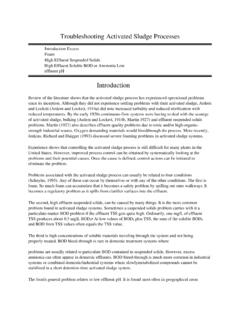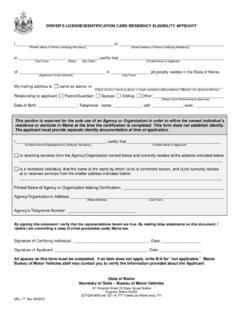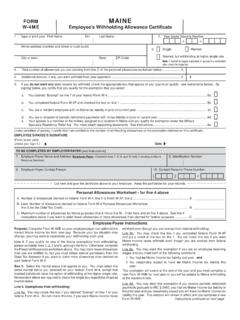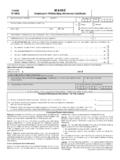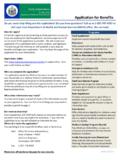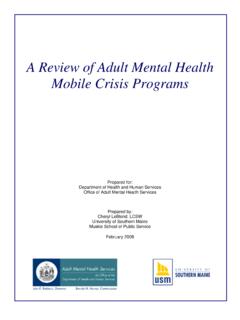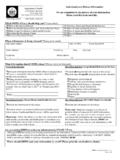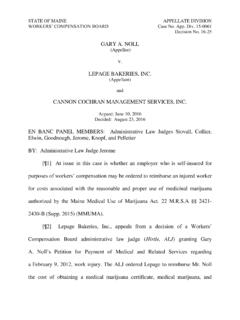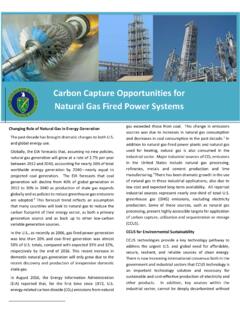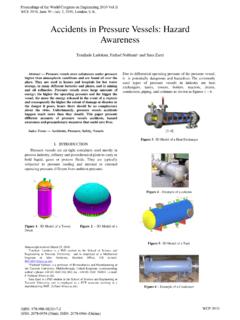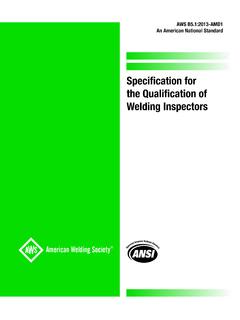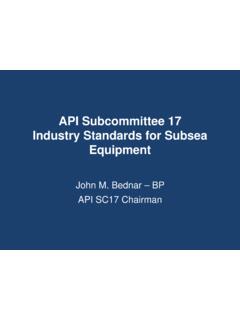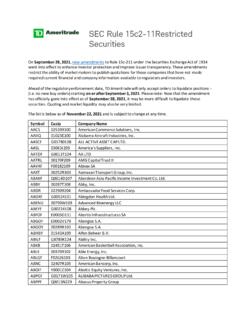Transcription of Status of Floating Offshore Wind Technology
1 Status of Floating Offshore wind Technology Walt MusialOffshore wind Research Platform Lead National Renewable Energy LaboratoryFebruary 26, 2020 NREL | 2 Speaker BioMr. Walt MusialPrincipal EngineerOffshore wind Research Platform LeadNational Renewable Energy LaboratoryGolden Colorado, USANATIONAL RENEWABLE ENERGY LABORATORY3 Spar: Achieves stability through ballast (weight) installed below its main buoyancy tank Challenges: Deep drafts limit port accessSemisubmersible: Achieves static stability by distributing buoyancy widely at the water plane Challenges: Higher exposure to waves More structure above the waterlineTension-leg platform (TLP): Achieves static stability through mooring line tension with a submerged buoyancy tank Challenges.
2 Unstable during assembly High vertical load moorings/anchorsAll Floating wind Substructures Rely on These Basic Archetypes SparSemisubmersibleTension Leg PlatformFigure credit: NRELNATIONAL RENEWABLE ENERGY LABORATORY4 First Phase of Floating wind Industry has Spawned Novel Substructure Concepts saitec offshoreGICONP rinciple Power Inc WindFloatIDEOLSBM OffshoreSCD nezzyStiesdal TetraSparEOLinkEquinor HywindAqua Ventus -UMaine Designs combine elements from the three archetypes Addressing the primary challenges with the archetypes is key to lowering cost The objective is to achieve Floating system lifecycle costs competitive in electricity markets Next phase.
3 Optimized engineering approach will yield commercial mass-produced utility-scale Floating wind systemsLocally produced VolturnUSsegmental concrete hullNew England Aqua of Maine VolturnUSConcrete semisubmersible design, has 55 DOE Advanced Technology Demonstration Program for Offshore wind & Mitsubishi-Diamond Generating Corporation to invest $100 m : MonheganIsland, Purchase Agreement contract signed construction 2022, COD 2023 Offshore tested 2013 Local fabrication ABS approved at scaleVolturnUSConcrete Semisub100m water depth10-12MW NREL | 6 Most Offshore wind Deployment Has Been on Fixed-bottom Support StructuresThe future Floating wind energymarket may be bigger than the fixed-bottom market27,208 MW Installed84 MW InstalledFixed BottomFloatingUnited Kingdom8508 MWGermany7441 MWChina6007 MWDenmark1925 MWBelgium1556 MWNetherlands1136 MWSweden196 MWLeading Offshore wind Countries(Installed Capacity)
4 Figures current as of 31 Dec 2019 NREL | 7 Floating Offshore wind Will be Developed Where Waters Are Too Deep for Current Fixed-Bottom Technology 80% of Offshore wind resources are in waters greater than 60 meters Floating wind enables sites farther from shore, out of sight, with better winds! Floating wind Technology is expected to be at deployed at utility scale by of this slide were adapted courtesy of Aker SolutionsSome Areas of the World Being Considered for Floating WindNREL | 82019 Global Floating Offshore wind Pipeline The total global Floating Offshore wind pipeline was 7,663 MW at the end of 2019, based on projects that have announced their planned capacity.
5 1,549 MW of Floating Offshore wind has reached the permitting stage The primary driver for pipeline expansion is the movement toward commercial-scale projects developing in Asia. NREL | 9 Cumulative Installed Offshore Floating wind Capacity by Country to Date At the end of 2019, there was 84 MW of installed Floating wind capacity globally, growing by 36 MW from 2018. Of this installed capacity, there are 16 projects, with 9 projects ( MW) in Europe and 7 ( MW) in Asia. Two pilot-scale projects comprising 3 and 5 turbines have been installed in Portugal (2020 labeled as 2019) and Scotland (2017), | 10 Cumulative Offshore Floating wind Capacity by Country Based on Announced COD Through 2025 Projects with announced CODs in 2025 or before total 3,313 MW.
6 A small number of commercial projects have announced a COD after 2025. Aqua Ventus I is the only project in the permitting stage and is now expected to reach commercial operations in | 11 Global Floating Substructure Market Share 5,847 MW of projects in the pipeline have announced their substructure type (76%) Semisubmersibles account for about 89% of installed and announced capacity Approximately 5% use or plan to use spars ( , Equinor s 30-MW Floating wind power plant). The remaining substructures are tension-leg platforms and ,816 MW of Floating projects have not reported their substructure typeNREL | Regulatory Activity There are 15 Lease Areasin the United States giving developers exclusive site control of about 21-GW of capacity BOEM has also identified 13 Call Areas Call areas are potential future wind energy areas that are under public reviewAtlantic RegionPacific Region ( Floating )NREL | 13 Where in the is Floating Offshore wind Being Considered?
7 Pacific Region High water depths require Floating Technology North Atlantic high demand, scarcity of shallow sites Great Lakes visual impacts may require farther distances into deeper waters 58% of the Offshore wind resource is in water depths > 60m - Floating foundationsPacificGreat LakesNorth AtlanticFigure credit: NRELNREL | 14 Atlantic Offshore wind resource is 55% of total the total resource Approximately 28-GW are in the project pipeline Nationwide State commitments continue to grow in the Atlantic Shallow sites are becoming scarcer 68% of Atlantic resource is greater than 60 m wind may be Necessary to Meet the Renewable Energy Goals for the Atlantic RegionChart Data Filters.
8 Greater than 12 nautical miles from shore Greater than 7 m/s Shallower than 1000 mNREL | 15 Balance of Station Non-Turbine Equipment Floating substructures Dynamic array cables connecting turbines Mooring and anchor system Installation and assembly Offshore and onshore substations Export cable (main electric cable to shore) Decommissioning after 25-30 yearsNon-turbine Costs Account for 75% of the Total Capital Cost for a Floating wind Farm Figure credit: NRELNREL | 16 Floating wind Turbines have Dynamic Array Collection Cable Dynamic array cables compensate for movement of Floating platform Numerous design features help isolate the static cable from platform movements Subsea cables may be buried or secured along ocean floorFigure credit: NRELNREL | 17 Typical Catenary Mooring Line/Anchor Configurations ChainMooring LineSynthetic MooringLineDrag Embedment AnchorsDrag Embedment Anchor Penetration 10m (33 ft)Radius Water Depth Mooring lines are at least 4 times longer than the water depthSynthetic Mooring LineFigure credit.
9 NRELP hoto credit: Walt MusialAdvanced Structures and Composites CenterCONFIDENTIALTop-View Comparison of Floating wind Turbines MooringsReduced Foot-print Synthetic Rope Moorings Are Half the Size of Traditional Chain Moorings to Reduce Impact on FishingWind TurbineReduction in Mooring Line Length by HalfSynthetic Rope Mooring Line RadiusTraditional Chain Mooring Line RadiusMooring Line 1 NREL | 19 Serial turbine, substructure assembly and component port delivery due to depth, waves off coastStorage and wet-tow out of assembled turbines with year-round access. Width/depth varies by substructure design20 100 acre storage and staging of blades, nacelles, towers, possible fabrication of Floating substructuresMinimum 40 600 ton lift capacity at 500 feet height to attach componentsMoorage for crew access vessels.
10 O&M berth for major repairs of full systemFloating Offshore wind Port and Infrastructure RequirementsWharfNavigation Channel and Wet StorageUpland YardCraneCrew Access & MaintenanceImage by Harland and Wolff Heavy Industries NREL | 20 Offshore Substation Utility-scale Offshore wind farms collect the power from each turbine at a high voltage substation for transmission to shore Floating substations are being developed with high voltage dynamic cables that allow the substations to move with the waves. London Array Substation on monopilePhoto Credit: Siemens PressNREL | 21 Floating Operations and MaintenanceSmall Repairs: Done in the field using service vessels -Sensors/computers, lubrication, electrical, preventative maintenance Turbine ServiceVessel Baltic 1 Photo: Walt MusialTurbine System Tow-out Photo.
